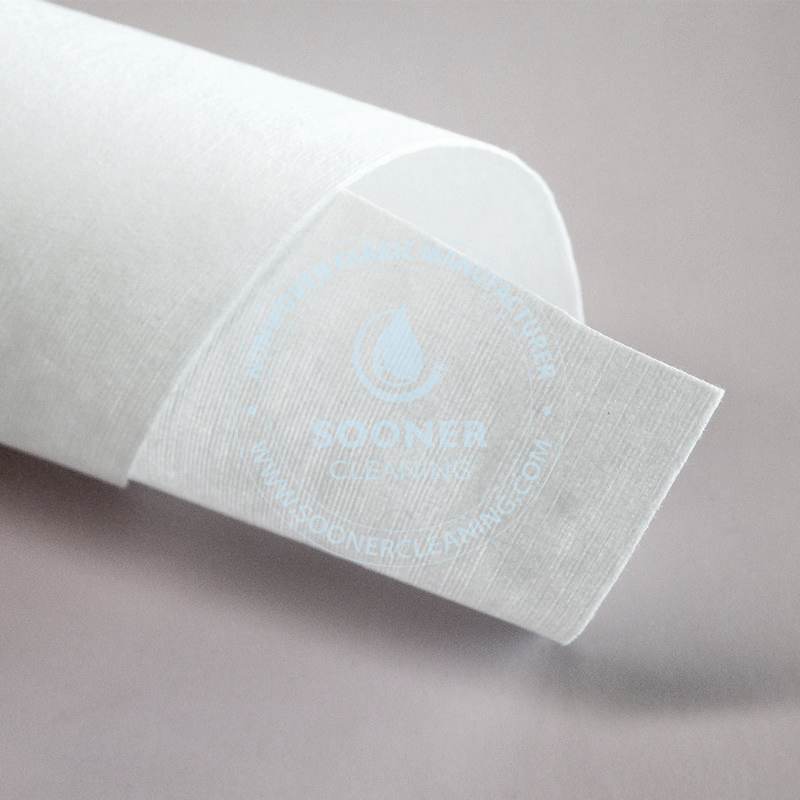As environmental awareness rises,
dispersible nonwovens are widely used in wet wipes and hygiene products due to their rapid decomposition properties. However, how to achieve rapid disintegration during the production process while maintaining the strength and usability of the product is an important challenge for manufacturers. In this paper, we will discuss the production process of dispersible nonwoven fabrics in depth, and analyse how to achieve rapid disintegration through technological innovation and process optimisation, while meeting product quality requirements.
I.Definition and market demand for dispersible nonwovens
Flushable nonwoven fabric is an environmentally friendly material that can decompose quickly in water, and is mainly used in the manufacture of disposable products such as wet wipes and sanitary napkins. Compared with traditional nonwoven fabrics, its biggest feature is that it can decompose quickly in the toilet or sewage system, reducing environmental pollution. As the global demand for environmentally friendly products grows, the market size of flushable nonwoven fabrics is expanding, but the complexity of its production process also puts forward higher requirements for enterprises.
II.Key factors for rapid decomposition of dispersible nonwoven fabrics
In order to realise the rapid decomposition of dispersible nonwovens, the following key factors need to be focused on during the production process:
2.1 Selection of fibre materials
The decomposition performance of dispersible nonwovens depends mainly on the fibre material. Commonly used fibres include:
Natural fibres: e.g. wood pulp, cotton fibre, etc., with good biodegradability.
Biodegradable synthetic fibres: such as polylactic acid (PLA) fibres, which are able to decompose rapidly under specific conditions.
By reasonably matching natural fibres and biodegradable synthetic fibres, rapid decomposition can be achieved while ensuring the strength of the product.
2.2 Fibre dispersion
The dispersibility of fibres in water is an important factor affecting the decomposition rate. The production process needs to optimise the length and fineness of fibres to make them more easily dispersed in water, thus accelerating decomposition.
2.3 Use of adhesives
Binders are often used in the production of nonwovens to enhance the bonding between the fibres. In order to achieve rapid decomposition, it is important to choose water-soluble or biodegradable binders and avoid the use of traditional chemical binders.
2.4 Optimisation of the production process
The production process has a direct influence on the decomposition properties of nonwovens. By optimising the production process, rapid decomposition can be achieved while ensuring product performance.
III.Production processes for dispersible nonwovens
The following are the key process steps in the production of dispersible nonwovens and how the process can be optimised to achieve rapid decomposition:
3.1 Fibre pre-treatment
Before the fibres enter the production line, they are pre-treated, including opening, blending and carding. The purpose of this step is to ensure a uniform distribution of the fibres and to lay the foundation for the subsequent processes. By controlling the length and fineness of the fibres, their dispersion in water can be improved.
3.2 Wet web formation
Wet web formation is one of the core processes in the production of dispersible nonwovens. The process suspends fibres in water to form a homogeneous fibre network, which is then dehydrated and dried to make nonwoven fabrics. The advantages of the wet web formation process are:
Uniform fibre distribution and high product strength.
The decomposition properties can be controlled by adjusting the process parameters (e.g. water flow rate, fibre concentration).
3.3 Hydroentanglement
The hydroentanglement process uses a high-pressure water stream to reinforce the fibre web and form a stable structure. In order to achieve rapid decomposition, the hydroentanglement process needs to control the pressure and temperature of the water flow to avoid over-reinforcement leading to a decrease in decomposition performance.
3.4 Drying and post-treatment
Drying is the final step in the production of nonwovens. By controlling the drying temperature and time, the decomposition properties of the product can be further optimised. In addition, post-treatment processes (e.g. adding degradable additives) can also improve the environmental performance of nonwoven fabrics.
IV.How to achieve rapid decomposition through technological innovation
In order to achieve rapid decomposition while ensuring product performance, manufacturers can adopt the following technological innovations:
4.1 Developing new biodegradable fibres
By developing new biodegradable fibres (e.g. modified PLA fibres), it is possible to significantly increase the decomposition rate without sacrificing product strength.
4.2 Optimise binder formulations
Selecting water-soluble or biodegradable binders and optimising their formulations can ensure rapid decomposition of the product in water while enhancing fibre bonding.
4.3 Introduction of intelligent production processes
By introducing intelligent production equipment and technology, process parameters (e.g. temperature, pressure, fibre concentration) can be precisely controlled to optimise the decomposition properties of the product.
V.Future trends of dispersible nonwovens
The market for dispersible nonwovens has a promising future as a result of increasingly stringent environmental regulations and growing consumer demand for environmentally friendly products.In the future, production processes will develop in the following directions:
Higher-performance biodegradable fibres: developing new fibres with both high strength and fast decomposition properties.
More environmentally friendly production processes: Reducing energy consumption and waste emissions in the production process.
Wider application areas: expanding the application of dispersible nonwovens in medical and agricultural fields.
VI.Conclusion
The production process of dispersible nonwoven fabrics is the key to achieve rapid decomposition. Through rational selection of fibre materials, optimization of production processes and introduction of technological innovations, manufacturers can ensure the performance of their products while achieving rapid decomposition to meet environmental and market demands. In the future, with the continuous progress of technology, dispersible nonwoven fabrics will play an important role in more fields and contribute to environmental protection.

